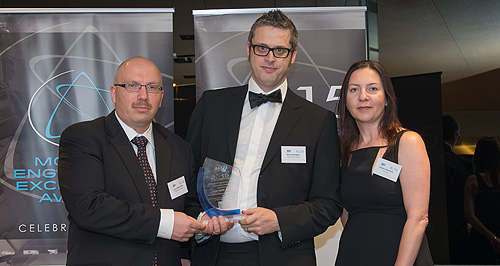Make / Model Search
News - General News - PeopleFord wins top SAE-A awardWinners: From left, Ford's Lauri Ohra-aho and Neil Lewington, and Suncorp's Jessica Sherlock at the SAE-A Mobility Engineering Excellence Awards. Vehicle crosswind stability can now be done at the pre-prototype stage23 Nov 2015 By IAN PORTER FORD Australia has won the top mobility engineering award for 2015 with a simulation system that can predict a vehicle’s behavior in a crosswind before the first prototype has been built. The system eliminates the potential for expensive re-engineering work after a design has been set and is ready for production. The company’s Vehicle Energy Management Engineering group received the Platinum Award at the annual Mobility Engineering Excellence Awards promoted by the Society of Automotive Engineers-Australasia. The award was received by aerodynamicist Neil Lewington and vehicle dynamics engineer Lauri Ohra-aho. Mr Lewington worked in Formula One aerodynamics at McLaren Racing between 2002 and 2007, the majority of that time under the leadership of the most successful racing car designer of the past 20 years, Adrian Newey. Mr Ohra-aho was recently named an inventor, along with three other engineers from the Geelong area, on a Ford Global Technologies patent for a bicycle that has a frame with inflatable segments, enabling it to be folded. Mr Lewington said testing for crosswind behavior used to be done only when a prototype was available. “Lauri approached me and said we needed a better way of predicting behavior in crosswinds. He said we wanted to be able to do the prediction very early on in the vehicle program, as opposed to waiting until we had a physical model.” The issue of crosswind behavior has become more important in recent years due to the lighter, low-drag vehicle configurations that are being produced in an effort to reduce fuel economy. These characteristics make vehicles more prone to crosswinds. “Normally we had to use a wind tunnel, with the vehicle stationary in the air and the ground flowing underneath it. “In this case we have actually moved the physical vehicle into the CFD (computational fluid dynamics) domain and by doing that we have eliminated a lot of the empirical correlation normally applying to that process and we have improved the accuracy.” Sensitivity to cross winds is not just about aerodynamics, according to Mr Ohra-aho. “You’ve got the physical properties, which is the sheer size and weight of the vehicle,” he said. “Then there’s the wheelbase and all the basics, and then the suspension set-up itself how soft it is, how hard it is, is it tuned for comfort, is it tuned for sportiness.” Mr Lewington said that, with prototypes costing upwards of $250,000, the new simulation program has the potential to save a lot of money by eliminating the need to change a design halfway through he program. If the design, still in digital form on a computer, shows it has problems in a crosswind, Mr Ohra-aho said there are several things that can be done. “You can employ underbody treatment, upperbody treatment, to deal with a cross wind tendency, but if you are not finding that out until very late in the program it can be expensive,” he said. “If you have already half-tooled the vehicle, what are you going to do.” The system is going to be rolled out across the commercial and business design groups throughout the Ford world. Gold awards were made in each of the key sectors covered by the SAE-A’s new approach to mobility: the rail category, the camper/caravan category and the heavy commercial vehicle category. The gold award in the camper/caravan sector went to AL-KO International, the Australian subsidiary of the German AL-KO group, for an electronic control system for caravans. The system is suitable for caravans with electrically operated brakes. It monitors the caravan for dangerous sideways movements and applies the brakes to restore stability. AL-KO has obtained a worldwide patent and the system is expected to have huge export potential for the Australian operation. The gold award in the rail category went to Bombardier for a redesign of the driver’s cab on the E-Class tram. Vision through the windscreen has improved from 58 to 77 degrees by repositioning the A-pillar and optimising its shape. This reduced the blind spot caused by the A-pillar from 26 to seven degrees. Vision has also been improved to the side of the driver’s cab. The gold award in the heavy commercial vehicle sector went to Intelligas Group, which has developed a new fueling system for trucks powered by compressed natural gas (CNG). The new system chills the CNG, allowing faster filling without the usual thermal penalty. It allows up to 50 per cent more CNG to be carried in the same space on the tractor. The SAE-A once again made a gold award to the young engineer of the year. This award went to Adnan Masinovic of Bombardier for the development of a rail-monitoring system that can be installed on Bombardier’s E-Class tram. This allows data on the condition of the rails in Melbourne’s extensive tram network to be gathered continually. Previously, data was collected by truck-mounted monitoring systems that could only operate outside network operating hours.  Read more |
Click to shareGeneral News articlesResearch General News Motor industry news |












Facebook Twitter Instagram